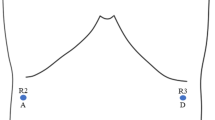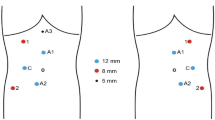Abstract
Background and objective
Benign retroperitoneal tumors (BRTs) are clinically rare solid tumors. This study aimed to compare the safety and efficacy of laparoscopic transperitoneal versus retroperitoneal resection for BRTs.
Methods
The clinical data of 43 patients who had pathologically confirmed BRTs and underwent laparoscopic resection in a single center from January 2019 to May 2022 were retrospectively analyzed. Patients were divided into two groups according to the surgical methods: the Transperitoneal approach group (n = 24) and the Retroperitoneal approach group (n = 19). The clinical characteristics and perioperative data between the two groups were compared. The baseline data and surgical variables were analyzed to determine the impact of different surgical approaches on the treatment outcomes of BRTs.
Results
No significant difference was observed between the two groups in gender, age, body mass index, the American Society of Anesthesiologists score, presence of underlying diseases, tumor size, tumor position, operation duration, intraoperative hemorrhage, postoperative hospital stay, intestinal function recovery time, and postoperative complication rate. The conversion rate from laparoscopic to open surgery was significantly lower in the Transperitoneal approach group than in the Retroperitoneal approach group (1/24 vs. 5/19, χ2 = 4.333, P = 0.037). Tumor size was an independent influencing factor for the effect of surgery (odds ratio = 1.869, 95% confidence interval = 1.135–3.078, P = 0.014) and had a larger efficacy on the retroperitoneal group (odds ratio = 3.740, 95% confidence interval = 1.044–13.394, P = 0.043).
Conclusion
The laparoscopic transperitoneal approach has the inherent advantages of anatomical hierarchies and surgical space, providing a better optical perspective of the targeted mass and improved bleeding control. This approach may have better efficacy than the retroperitoneal approach, especially in cases of a large tumor or when the tumor is located near important blood vessels.




Similar content being viewed by others
Data availability
The raw data supporting the conclusions of this manuscript will be made available by the corresponding author, without undue reservation, to any qualified researcher.
References
Gemici K, Buldu İ, Acar T, Alptekin H, Kaynar M, Tekinarslan E et al (2015) Management of patients with retroperitoneal tumors and a review of the literature. World J Surg Oncol 13:143
Tambo M, Fujimoto K, Miyake M, Hoshiyama F, Matsushita C, Hirao Y (2007) Clinicopathological review of 46 primary retroperitoneal tumors. Int J Urol 14(9):785–788
Gamboa AC, Gronchi A, Cardona K (2020) Soft-tissue sarcoma in adults: an update on the current state of histiotype-specific management in an era of personalized medicine. CA Cancer J Clin 70(3):200–229
Gulati V, Swarup MS, Kumar J (2022) Solid primary retroperitoneal masses in adults: an imaging approach. Indian J Radiol Imaging 32(2):235–252
(2020) Intercontinental collaborative experience with abdominal retroperitoneal and pelvic schwannomas. Br J Surg 107(4):452–463
Shi C, Li F, Wang Y, Pei L, Wang T (2018) Retroperitoneoscopic resection of retroperitoneal nonadrenal ganglioneuromas: our technique and clinical outcomes. Int Braz J Urol 44(6):1166–1173
Kang CM, Kim DH, Seok JY, Lee WJ (2008) Laparoscopic resection of retroperitoneal benign schwannoma. J Laparoendosc Adv Surg Tech A 18(3):411–416
Xu W, Li H, Ji Z, Yan W, Zhang Y, Xiao H et al (2015) Comparison of retroperitoneoscopic versus transperitoneoscopic resection of retroperitoneal paraganglioma: a control study of 74 cases at a single institution. Medicine (Baltimore) 94(7):e538
Clavien PA, Barkun J, de Oliveira ML, Vauthey JN, Dindo D, Schulick RD et al (2009) The Clavien-Dindo classification of surgical complications: five-year experience. Ann Surg 250(2):187–196
Romeo L, Bagolini F, Ferro S, Chiozza M, Marino S, Resta G et al (2021) Laparoscopic surgery for splenic injuries in the era of non-operative management: current status and future perspectives. Surg Today 51(7):1075–1084
Zhao G, Cao S, Cui J (2014) Fast-track surgery improves postoperative clinical recovery and reduces postoperative insulin resistance after esophagectomy for esophageal cancer. Support Care Cancer 22(2):351–358
Sassa N (2020) Retroperitoneal tumors: review of diagnosis and management. Int J Urol 27(12):1058–1070
Buia A, Stockhausen F, Hanisch E (2015) Laparoscopic surgery: a qualified systematic review. World J Methodol 5(4):238–254
Ribeiro MA Jr, Elias YG, Augusto SS, Néder PR, Costa CT, Maurício AD et al (2020) Laparoscopic resection of primary retroperitoneal schwannoma: a case report. World J Clin Cases 8(18):4114–4121
Abe T, Sazawa A, Harabayashi T, Oishi Y, Miyajima N, Tsuchiya K et al (2016) Laparoscopic resection of paraaortic/paracaval neurogenic tumors: surgical outcomes and technical tips. Surg Endosc 30(10):4640–4645
Ahn KS, Han HS, Yoon YS, Kim HH, Lee TS, Kang SB et al (2011) Laparoscopic resection of nonadrenal retroperitoneal tumors. Arch Surg 146(2):162–167
Petrucciani N, Sirimarco D, Magistri P, Antolino L, Gasparrini M, Ramacciato G. (2015) Retroperitoneal schwannomas: advantages of laparoscopic resection: review of the literature and case presentation of a large paracaval benign schwannoma (with video). Asian J Endosc Surg 8(1):78–82.
Ji JH, Park JS, Kang CM, Yoon DS, Lee WJ (2017) Laparoscopic resection of retroperitoneal benign neurilemmoma. Ann Surg Treat Res 92(3):149–155
Simutis G, Lengvenis G, Beiša V, Strupas K (2014) Endoscopic retroperitoneal adrenalectomy for adrenal metastases. Int J Endocrinol 2014:806194
Xu W, Li H, Ji Z, Yan W, Zhang Y, Zhang X et al (2016) Retroperitoneal laparoscopic management of paraganglioma: a single institute experience. PLoS ONE 11(2):e0149433
Nathan H, Raut CP, Thornton K, Herman JM, Ahuja N, Schulick RD et al (2009) Predictors of survival after resection of retroperitoneal sarcoma: a population-based analysis and critical appraisal of the AJCC staging system. Ann Surg 250(6):970–976
Chen J, Hang Y, Gao Q, Huang X (2021) Surgical diagnosis and treatment of primary retroperitoneal liposarcoma. Front Surg 8:672669
Fujimoto N, Kubo T, Hisaoka M, Udo K, Yokomizo A, Shibuya T et al (2018) Demographics, management and treatment outcomes of benign and malignant retroperitoneal tumors in Japan. Int J Urol 25(1):61–67
Acknowledgements
We thank everyone, who supports us to finish this study.
Funding
This work was supported by grants from the National multidisciplinary collaborative diagnosis and treatment capacity building project for major diseases (Grant No. TJZ202104), the Natural Science Foundation of China (Grant Nos. 82270643, 82070644 and 82170621), the Science and Technology Major Program of Sichuan Province (Grant No. 2022ZDZX0019), 1.3.5 project for disciplines of excellence, West China Hospital, Sichuan University (Grant Nos. ZYJC18008, ZYGD22006).
Author information
Authors and Affiliations
Contributions
QX, ZH, CL, JH: Guarantor of integrity of the entire study, Study concepts, Study design, Manuscript preparation—editing—review, and Definition of intellectual content. QX, ZH, GQ, ZJ, SM: Literature research, Clinical studies, Experimental studies, and Data acquisition. QX, ZH: Data analysis and Statistical analysis.
Corresponding authors
Ethics declarations
Disclosures
Ziqi Hou, Qingyun Xie, Guoteng Qiu, Zhaoxing Jin, Shizheng Mi, Chang Liu and Jiwei Huang have no conflicts of interest or financial ties to disclose.
Ethical approval
This study was approved by the Ethics Review Committee of the West China Hospital.
Additional information
Publisher's Note
Springer Nature remains neutral with regard to jurisdictional claims in published maps and institutional affiliations.
Rights and permissions
Springer Nature or its licensor (e.g. a society or other partner) holds exclusive rights to this article under a publishing agreement with the author(s) or other rightsholder(s); author self-archiving of the accepted manuscript version of this article is solely governed by the terms of such publishing agreement and applicable law.
About this article
Cite this article
Hou, Z., Xie, Q., Qiu, G. et al. Safety and efficacy of laparoscopic transperitoneal versus retroperitoneal resection for benign retroperitoneal tumors: a retrospective cohort study. Surg Endosc 37, 9299–9309 (2023). https://doi.org/10.1007/s00464-023-10504-0
Received:
Accepted:
Published:
Issue Date:
DOI: https://doi.org/10.1007/s00464-023-10504-0




